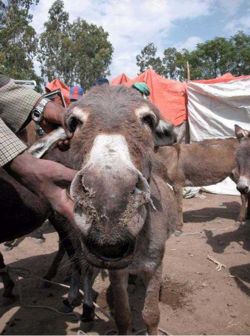Difference between revisions of "Equine Influenza Virus - Donkey"
m (Text replace - '{{review}}' to '') |
|||
| (One intermediate revision by the same user not shown) | |||
| Line 1: | Line 1: | ||
| − | |||
| − | |||
==Introduction== | ==Introduction== | ||
[[Image:EIV donkey.jpg|right|thumb|250px|<small><center>Equine influenza infection (Image courtesy of [http://drupal.thedonkeysanctuary.org.uk The Donkey Sanctuary])</center></small>]] | [[Image:EIV donkey.jpg|right|thumb|250px|<small><center>Equine influenza infection (Image courtesy of [http://drupal.thedonkeysanctuary.org.uk The Donkey Sanctuary])</center></small>]] | ||
| Line 18: | Line 16: | ||
Donkeys should be protected with prophylactic '''vaccination''' protocols as per the manufacturer’s recommendations. | Donkeys should be protected with prophylactic '''vaccination''' protocols as per the manufacturer’s recommendations. | ||
| + | ==Literature Search== | ||
| + | [[File:CABI logo.jpg|left|90px]] | ||
| + | |||
| + | |||
| + | Use these links to find recent scientific publications via CAB Abstracts (log in required unless accessing from a subscribing organisation). | ||
| + | <br><br><br> | ||
| + | [http://www.cabdirect.org/search.html?q=title%3A%28influenza%29+AND+od%3A%28donkeys%29 Equine Influenza in donkeys publications] | ||
| + | |||
| + | [http://www.cabi.org/cabdirect/FullTextPDF/2010/20103139249.pdf ''' Equine influenza: an overview.''' Waghmare, S. P.; Mode, S. G.; Kolte, A. Y.; Namrata Babhulkar; Vyavahare, S. H.; Ajit Patel; Veterinary World, Rajkot, India, Veterinary World, 2010, 3, 4, pp 194-197, 8 ref. - '''Full Text Article'''] | ||
==References== | ==References== | ||
Latest revision as of 10:59, 1 November 2010
Introduction

Influenza virus (of the family Orthomyxoviridae) infection in the donkey is similar to the one in the horse.
Clinical Signs
As in the horse, infection with the influenza virus occurs with clinical signs of pyrexia, nasal discharge, cough, lymphadenopathy, depression and inappetance. Reports suggest that there is a higher mortality from the disease in donkeys and an increased rate of complications, such as bronchopneumonia and hyperlipaemia (Holland et al, 1995; Rose et al, 1970).
Diagnosis
As with herpes virus infection, definitive diagnosis requires laboratory confirmation, and strict hygiene and isolation procedures should be implemented in the event of an outbreak. Due to the risk of complications in the donkey, it is recommended that antibiotics are administered early in the course of the disease and that attention is paid to appetite and serum triglycerides.
Control
Donkeys should be protected with prophylactic vaccination protocols as per the manufacturer’s recommendations.
Literature Search
Use these links to find recent scientific publications via CAB Abstracts (log in required unless accessing from a subscribing organisation).
Equine Influenza in donkeys publications
References
- Thiemann, A. (2008) Respiratory problems In Svendsen, E.D., Duncan, J. and Hadrill, D. (2008) The Professional Handbook of the Donkey, 4th edition, Whittet Books, Chapter 7
- Holland, R.E., Tudor, L.R., Timoney, J.F., Anzai, T., and Chambers, T.M. (1999). ‘Equine Influenza disease in Donkeys: severe brochopneumonia due to clonal invasion by Streptococcus zooepidemicus’. Equine Infectious diseases VIII,. W. Wernery, J.F. Wade, J.A. Mumford and O.R. Kaaden (eds). R. & W. Publications, Newmarket. pp 548-549 .
- Rose, M.A., Round, M C., and Beveridge, W.I.B. (1970). ‘Influenza in horses and donkeys in Britain’. Veterinary Record, 86. pp 768-769.
|
|
This section was sponsored and content provided by THE DONKEY SANCTUARY |
|---|
